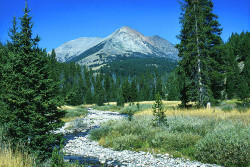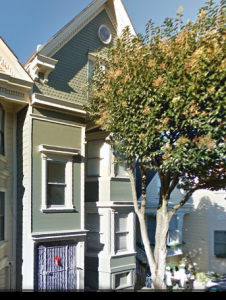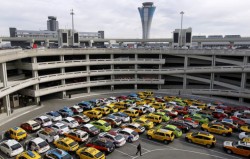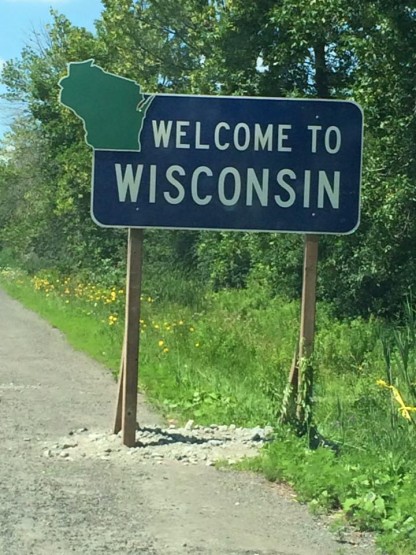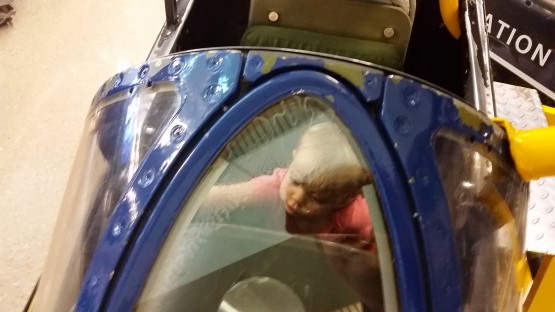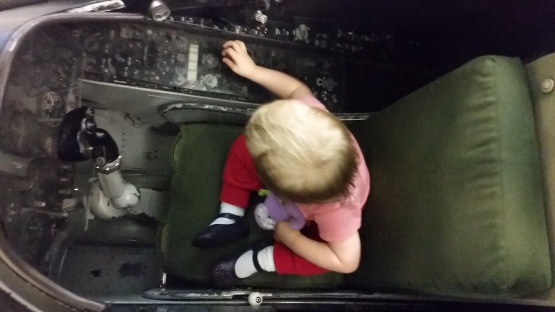Category Archives: Road
The SWINCAR. It’s an all-electric off-road vehicle with a very, VERY flexible chassis (and ya’ll can just get your minds out of the gutter right now, it ain’t that kind of flexible chassis).
The key thing to note is the lack of any axles. Each wheel has it’s own electric motor, which allows for a low slung design and a wide range of motion for the suspension arms. Some years back I had drawn up some initial designs for something similar, but with a higher center of gravity. Alas, no money, and battery technology wasn’t quite there yet, so it was all just on paper.
[This post is part of a series. Part I is here.]
“Don’t pick up any black people, especially if there’s more than one of them,” the experienced cabbie told me. “Stay out of Sunnydale, Third Street, and Bayview/Hunter’s Point. Don’t stop for anybody there”
It was my first day, we were playing pool on the immense 9′ long and slow rolling pool table that appeared to suspend the laws of gravity and friction in order to prove Newton’s first law of motion. No matter how slowly the balls rolled, they kept going until they reached the other bumper far far away. And between shots he was giving me tips on making money and staying alive as a cabdriver.
I didn’t want to be that guy. I remembered Clarence Thomas during his confirmation hearings talking about how hard it was for him to get a cab in D.C., and thinking no matter what kind of person he might be personally, that wasn’t right. And I knew I’d have no trouble stopping for a professionally dressed black person, or an older black person. But…
I was only a couple years removed from my no-stoplight Midwestern farm town, and my safe little religious college. And I knew that cabbies had the highest homicide rate of any profession, mostly from getting shot in the back of the head without warning, mostly at night, the shift I’d chosen. And only a year and a half before I’d gotten jumped and beaten while riding my bicycle through the projects. It had been tough working through my fear of young black men afterward. When I heard footsteps behind me at night, I would tense up and turn, and I would relax if I saw anyone other than a young black male. And because I had friends who were young and black, I like I was insulting my friends every time I did that, so I consciously worked on overcoming that fear, and did so pretty successfully, mostly by telling myself that’s guy’s probably as nervous about me as I am about him.
But as a cabbie? Young black males, particularly in groups, particularly if they were dressed a certain way? I wasn’t sure if I’d pick them up. (more…)
I didn’t really want the job, but I’d been looking for a while, and I couldn’t ask my girlfriend to keep covering my share of the rent. And reportedly it was good money, if dangerous.
.
 I had been a bike messenger, and was proud of it. But I’d taken a summer off to work in Yellowstone, and while hiking on Electric Peak scorched by the fires of ’88, my foot slid in the deep ash and I went down with my kneed twisted under me.
I had been a bike messenger, and was proud of it. But I’d taken a summer off to work in Yellowstone, and while hiking on Electric Peak scorched by the fires of ’88, my foot slid in the deep ash and I went down with my kneed twisted under me.
The pain was immediate, the knee unable to bear my wait, and I was alone, three miles from my car. The hike out was excruciating, as was every hike I tried to take the rest of the summer, particularly the foolishly agreed to hike along Sky Rim trail, when my brother threatened to kill and eat me if I died, and which ended with a long steep downhill I managed by throwing my left leg forward and dragging my right leg up, one lunge at a time, for mile after mile.
But by the time I made it back to San Francisco–after sadly breaking up with my summer girlfriend, trying unsuccessfully to move to Missoula, Montana, and having the car I bought that summer blow the engine an hour out on the drive from Missoula to to San Fran–I could walk on flat ground again, and I went back to the messenger shop and got on my bike.
I soon had a new girlfriend, a new apartment with her, and the beginning of a long happy life together, but the same old pain. Every day on the bike was excruciating, and finally I was forced to quit. My friend Jake had called me a lifer. I lasted two years.
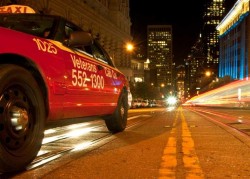
I found out that nobody wanted to hire a former bike messenger. Our reputation preceded me. So cabbie it was, an occupation that, like messengering, had a handful of long-timers but a lot of turnover among those who tried it out and found it wasn’t for them. I remembered suppressing a sneer at a former roommate who’d been a bike messenger for half a day. Karma–I was a cabbie for a whole three months, hating the job every day, hating urban driving, hating drunks in my cab, hating the fat slob of a dispatcher for his sneering superiority and for assigning us low guys in the hierarchy the shittiest most poorly maintained cars in the shop, hating having to arrive at 2 p.m. and wait around up to two hours waiting for my name to be called for an available car, hating the feeling that I was a college dropout who couldn’t get a better job.
The other cabbies were pretty good guys, though, at least the ones who bothered to talk to me. One was a former bookstore owner, who found it hard to get a better job because nobody wanted to hire someone who’d been their own boss, afraid they’d be unable to take orders from someone else. Another like to play a game of pool before heading out, on the shop’s monstrously long table, where the balls rolled mysteriously slowly, but rolled on and on an on, in apparent defiance of the laws of physics.
And they generously gave me tips on the job: avoid the airport–you’ll get big fares, but the long wait times aren’t worth it; ignore the radio calls and stick to areas where people are likely to flag you down; if you get a drunk asshole in your cab, drive to the nearest police station; stay out of Hunter’s Point, Bayview, Third Street, Sunnyside; don’t pick up black people.
Some of the advice I took, some I didn’t.
And I have a few stories I will tell.
[Image credits:
- Bike Messenger: http://www.gibsonpictures.com/MoreBikeMessengerAndCommuting.jpg;
- Electric Peak: “Electric-peak-trees”. Licensed under Public Domain via Wikimedia Commons – https://commons.wikimedia.org/wiki/File:Electric-peak-trees.jpg#/media/File:Electric-peak-trees.jpg
- Skyrim Trail: http://www.spiriteaglehome.com/cdt06%20images/WY220%20Sky%20Rim%20Trail.jpg
- Apartment House: Google.
- Cab: http://img.sfbay.ca/home/wp-content/uploads/2014/09/taxi-788×563.jpg
- Cab staging area, SFO: http://ww3.hdnux.com/photos/33/24/06/7160226/5/920×920.jpg]
I’ve mentioned here and there that we’re going on a trip, and so we are! To Alaska, where my sister-in-law Ellie will be getting married for the third and we hope joyfully permanent time.
This will be the first trip we’ve taken in 2015. I’m looking forward to seeing the in-laws, and looking forward to the weather, but am really not looking forward to the flights, which will involve two days in each direction. The flight from Dulles (yay!) to Zaulem will be be direct, which is better than adding a fourth leg to the flight but but is an awfully long time to spend in a plane. We’ll be spending the night in Zaulem and then on to Anchorage and then Fairbanks. It’ll be our first time in Zaulem since we moved away, though it’ll pretty much be a matter of going to a hotel room and then back to the airport.
We don’t fly exceptionally well as a family. The ways in which my personality’s and Clancy’s clash are accentuated with every phase of such transportation. Kids, it turns out, make transportation more complicated. Unfortunately, we live just far enough away from the family (nevermind Alaska!) that driving is also extremely rough.
It’s almost enough to make me a fan of rail…
A new study suggests that self-driving cars will be a boon to public safety. There are still a lot of things that the autocars cannot handle, however, and so it may be a while.
In the meantime, we’re likely looking at a future where cars take more and more off our hands and, piece by piece, do the driving for us. This could turn out to be a mixed bag, however, if we become too reliant on these vehicles too quickly. The fear is that risk compensation will cause more problems than the semi-automation will fix.
It’s something that makes a certain disconcerting sense to me. But it’s also something that’s not very new.
When I was young and she was alive, I used to get into arguments with my aunt on the subject of cruise control. She thought that cruise control was an absolutely horrible invention because it meant that drivers would pay less attention and therefore cause more accidents.
“What about automatic transmission?” I asked.
Completely different she explained, though she was never quite able to explain why automatic transmission made driving easier but cruise control made driving too easy. Why automatic transmission made it so that you could focus on your driving, while cruise control made it so that you wouldn’t. Maybe there is a good explanation, but I think a lot of it revolves around innovations that occur when you’re young enough to be interested in innovations.
Which is what I think about when I worry about drivers not paying sufficient attention to the road. I think cruise control is as awesome as my aunt thought automatic transmissions were, and I tend to chalk up my concern to automatic car distancing to her concerns about cruise control.
Then again, every innovation is different. And I do recall reading somewhere that Google actually had to step back on the automation because it’s drivers weren’t paying the attention that they needed to be taking. So maybe there’s something to it.
The Washington Post recently wrote about the woes of Dulles International Airport:
A recent study found that Dulles generated more than $1.2 billion in tax revenue and nearly $10 billion in labor income. More than 19,000 people work at Dulles, but nearly 250,000 jobs are tied to the airport, according to the study, commissioned by the Metropolitan Washington Airports Authority.
“The shift to National — it’s a serious problem for the financial viability of Dulles,” said Jonathan Gifford, director of the Center for Transportation Public-Private Partnership Policy at George Mason University.
The MWAA needs both airports to succeed for its bottom line, but in its version of a perfect world, Dulles would be booming. Instead, the explosive growth at National is creating headaches for the authority. From a steep rise in noise complaints from nearby Arlington County residents to concourses so crowded that passengers say they feel like sardines, authority officials are scrambling to find more space at a facility that has little to spare.
We’re significantly closer to Dulles than we are to Reagan National (DCA) or Baltimore-Washington (BWI). When we moved here, we figured that it would mostly be Dulles that we would fly out of, but I think we’ve only been there once. We’ve used BWI twice, and DCA four or five times. Reagan is a notably small airport, the smallest major airport I’ve used. I’ve ever flown in and out of. Which is actually kind of convenient, in some respects, because we invariably end up at whatever gate is farthest down the way. But it would be more convenient to cut a half-hour off our drive and avoid DC entirely, which would be the case with Dulles. I would think with the growth of NoVA and the suburbs of DC extending further and further out that there would be more use for an airport that wasn’t located right in the thick of things, and that Dulles wouldn’t need the congressional meddling it’s apparently relied on.
But that’s apparently not the case.
Meanwhile, WaPo asks what to call the airport that isn’t Dulles or BWI. It’s a contentious issue, as Ronald Reagan is Ronald Reagan, some question the decision to name the airport after him, and a lot of liberals and air traffic controllers refuse to call it by that name.
We just call it DCA, though apparently we don’t count as “Washington Area” on their survey because we’re not in one of the listed counties. Which itself is strange, because for purposes of this survey the relevant demographic should be those who actually fly out of the airport.
BusinessWeek has a good piece on the inconvenient intersection between toll roads and rental cars. Where some might see inconvenience, rental companies see profits:
Rental companies don’t absorb the cost of tolls. Instead, they typically offer customers two options: paying a flat daily fee upfront to lease a transponder, or paying administrative fees of as much as $25 for each unpaid toll to the rental company, plus anything owed to the state. Both greatly inflate the cost of tolls for car renters.
That’s prompted demands by irate renters for states to intervene. “I’m angry beyond belief and can’t even imagine coming back to your state,” Roxanna Usher of Redwood Valley, Calif., wrote in a Jan. 13 complaint to Florida’s attorney general after Dollar Rent a Car billed her $30 in administrative fees for two unpaid tolls totaling just $2.74. “It’s disgusting what you’re doing to tourists.” Usher’s is among nearly 100 complaints received by Florida’s attorney general in the past 18 months from rental car customers.
The fees have led to lawsuits against rental car chains, including a suit filed against Dollar earlier this year by a Florida couple, Stephen and Anne Sallee, who rented a car in Dallas in November 2013 and got hit with $60 in fees for $4.70 in unpaid tolls. “Dollar’s charge is actually not an administrative fee; it’s a veiled, mischaracterized, and undisclosed profit center” that helps Dollar advertise low daily rental rates for their cars, the couple claim in their suit, which was filed in U.S. District Court in Tulsa. They’re seeking class-action certification for other Dollar customers assessed with similar charges. “Dollar prides itself on complying with all laws,” Paula Rivera, a spokeswoman for Dollar’s parent company, Hertz Global Holdings (HTZ), wrote in an e-mail. “We deny allegations that the company sells customers products they don’t want, and we intend to defend the case referenced vigorously.”
And this is why we can’t have nice things. Or, rather, why we can’t leave companies to their own devices when it comes to how to make a profit. Moneytraps, which I would define as a company’s ability to make a profit based on services uneasily avoided, rather than particularly desired. In an airline context, I consider luggage fees to be legitimate, but $200 charges on not-last-minute changed flights to be a moneytrap. In the banking context, it’s overdraft fees. In the rental car context, it’s gas refilling policies and… this.
It seems ridiculous that we should have to regulate what kind of administrative fees that rental agencies can charge, but when they use moneytraps like this for profit centers, outside intervention does start to become justified.
To be fair, the market itself may sort this out. The last time I was in Colosse, we rented a car that had a transponder in it for no fee if we didn’t use it, and a flat $2 (plus expenses) if we did. They made some money off of it, but not an unreasonable amount. Unfortunately, a lot of people really are fixated on the price tag, so a company like Dollar can advertise really low rates while making their profits off moneytraps.
The government itself shoulders some of the blame, in this case, and could potentially resolve the issue without any regulation at all. But the government, too, has incentives for people to drive through EZ-Tag lanes without having a tag. I was recently flagged for having gotten in the wrong lane, racking up a $4 in tolls… and $50 in administrative charges. No rental company involved.
Exacerbating the situation is that tag-only roads are becoming increasingly common. Where there is no toll booth and so if you don’t have a tag, you’re stuck. My view is that when states start doing this, they need to be really careful about either (a) offering tags at little or no cost, or (b) having cost-appropriate administrative fees for people who don’t have them.
The end result of our $54 bill was that Clancy and I finally decided to get EZ-Tags. Which a part of us resents, because as far as we were concerned, we’re willing to stop and pay a toll. But the cost of the tags are reasonable, in our state, and we’ll save money simply by not making errors.
I was actually pretty excited about our next trip to the airport, where we are most likely to get in trouble as far as tolls are concerns. The upside to resigning ourselves to the tags is that we’d be able to sweep right through the toll booths. Then we moved, and now the quickest routes to the main airport we use no longer require tolls anyway.
Today was spent mostly in transit, as we take our annual family trip to the beach.
Lain has officially kissed a boy, for the first time. I didn’t see it because Clancy and I had split up duties and I had parked the car and was walking to the gate. But evidently she made a friend. Lain has learned to kiss I guess by watching Clancy and I, and had taken to trying to kiss us. Well, she kissed the boy, who was a little under a year old.
The other thing, which is slightly less interesting but was more fun for her, was that she got to sit in the deck of a fighter plane (of sorts). They had one at the airport of our final destination. She seemed to enjoy pulling on the nobs and levers. My primary observation – independent of her enjoyment – is that it’s a good thing I never had designs on being a naval or air force pilot, because I would never fit in one of those things.
I was operating on less than five hours of sleep, and felt it every bit of the day.
I find that I have completely lost the ability to sleep on planes, no matter how tired I am. If I couldn’t do it today, where I was so sleepy I was almost in pain, I simply can’t do it.
Lain didn’t sleep on either leg of the flight plan. She did nap a bit on the drive from the airport, but that was about it. She’s really excited to see her grandma and grandpa.
Taking a vacation in the middle of a move is both great and terrible. It’s great because you need the break. It’s terrible because trips involve packing, and packing is best done when you know where everything is.
Because we got here so late, we didn’t get a chance to go out on the beach. Which is just as well, because last week a couple of friends shared the following two images:
Those would be stingrays. Stingrays are a thing where we are. I’ve never seen them in that number, but at least in that number you know to stay the heck away. But now I’ve got stingrays on my mind.
The Crossover reigns supreme!
These days, three times as many crossovers are sold as SUVs and minivans combined. Even SUVs in their Clintonian fin-de-siècle glory days cannot touch the growth of the crossover. Just take in these numbers.
Last year, roughly speaking, two crossovers were purchased for every three cars. It’s tough to compare apples to apples, but in April, IHS Automotive analyst Tom Libby noted that small crossovers were the single best selling segment of any type of vehicle, including midsize sedans, which are the staple crop of the automotive industry.
“If the trend we have witnessed in the first two months of 2014 continues for the remainder of 2014,” Libby wrote, “it would mark the first time in recent memory—if not ever—that a car segment did not lead the industry.”
Now halfway through the year, “it seems like that might be case,” Libby’s colleague Brinley said, though obviously there’s still some time left in the year.
In comparison with the rise of Android, say, or WhatsApp, this change may not look impressive. But this is an industry that measures change in decades, that requires new factories to build different kinds of cars, and that has been selling something that someone born in 1890 could understand.
In other words, in the car business, the crossover is what monumental, generational change looks like.
It’s not often that I read about some big thing that has taken over the market that I actually got a couple of years ago, but we got our Forester in 2011. My Escort was running out of steam. In addition to wanting something with AWD, we wanted something that worked reliably in cold weather, which the Escort didn’t and which was a problem in Arapaho.. We were also looking towards having kids and an Escort was a two-door.
The crossover was almost perfect for our short-term needs. In fact, I looked at the crossovers and the full-size sedans and really struggled to think of a good reason to get the latter. The price was competitive and the mileage was similar.
After much investigation and deliberation, we went with the Subaru Forester. Subaru, it turns out, is really banking it on the crossover revolution:
When minivans were popular, Subaru built crossovers. When SUVs were popular, Subaru built crossovers. Now, finally, crossovers are popular. And so are Subarus. {…}
Subarus are not as quirky as they once were, but when I recently climbed behind the wheel of a 2014 XV Crosstrek Hybrid, the immediate impression was of familiarity – this little wagon was a kindred spirit to the ’82 that I learned to drive on. Same slightly butch ride height, same raspy four-cylinder gurgle, same invincibility in the snow. And I did have occasion to try it in the snow, as I found myself driving the Crosstrek during a rare North Carolina blizzard.
Notably, The Atlantic’s article mentions how similar all of the crossovers have become but Subarus resist that trend somewhat. Had we lived in a different part of the country, I would have more seriously considered a Mitsubishi Outlander, which also looks a bit different. But Mitsubishi lacked dealerships in Arapaho and Subarus are common. Sufficiently so to be a social marker next to the also-popular Jeeps.
The environmental repercussions are mixed. A lot of the market-gain from crossovers has come at the expense of vans and SUVs, which is a gain. But cars’ share of the market has also been declining, and that may not be such a good thing.
What’s been most helpful to us has been the extra cargo space. Sedans have themselves become much better with the storage space in recent times, but having the open space with the back seats down has been priceless.
In a way it’s frustrating, of course, because most of the time we would be perfectly fine with my wife’s sedan that gets better mileage. It could be advantageous to both us and the environment to have a “cargo and family trips” vehicle and two sedans for the rest of our driving. Unfortunately, our system of auto insurance penalizes such things, and so we end up with more vehicle than we need most of the time.
Our next vehicle will probably be a larger one, exacerbating the issue. The ironic thing is that as the appeal of the crossover becomes wider, I have been wondering if we should have gone straight to the larger vehicle. When child #2 comes (hopefully sometime next year), two parents and two kids with two car seats and a dog will be kind of tight.

